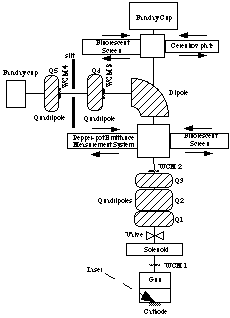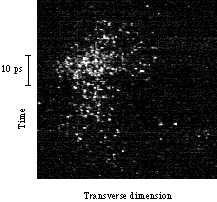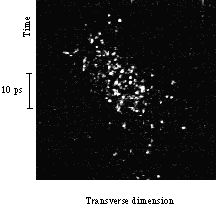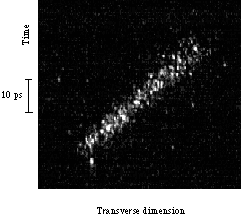CANDELA photo-injector is made of a 2-cell S-band
RF gun, using a dispenser cathode illuminated by a Ti:sapphire
laser. This electron source provides a single bunch (at 12.5 Hz),
with a charge of 1 nC and an energy of 2 MeV. This paper presents
the measurement of the bunch length which is done 1.8 m downstream
of the gun exit. The measurement system includes a 0.3 mm thick
sapphire plate used to produce Cerenkov radiation, a 27 m long
optical beamline and a streak camera. Bunch lengths of less than
10 ps were measured. These measurements are the first experimental
proof of the fast response of dispenser photocathodes.
Many applications (including high energy linear colliders,
free electron lasers, and X-ray radiation sources) need electron
sources that can produce intense, bright and short electron pulses.
The photo-injector being very attractive with these respects,
it is studied in many laboratories around the world [1]. The CANDELA
photo-injector is part of this worldwide effort, and has its own
specific features. It is made of two decoupled 3 GHz cells [2,
3, 4] and uses a dispenser photocathode [5]. The Ti:sapphire laser
system [6] used to illuminate this photocathode is able to produce
subpicosecond pulses. To date, CANDELA that was first operated
at the end of 1993 [7], is the only S-band photo-injector to use
such a short laser. Basic experimental results, such as quantum
efficiency were already reported in [8]. This paper is therefore
concentrating on new experimental results concerning bunch length
measurement. After presenting the experimental set-up, results
are given for several conditions (laser spot size and charge).
The gun RF cavity characteristics are given in reference [9], the cathode performance in reference [8] and the laser system in reference [6]. In order to analyze the beam properties, several diagnostics systems are located along the beamline as shown in figure 1.
Bunch charge is measured with Faraday cups and wall
current monitors. The latter have the advantages to be non- destructive
and to respond only to the photo-emitted current. The Faraday
cup followed by an integrator gives an indication of the total
current (photo-current plus dark current). Two ceramic fluorescent
screens and CCD cameras allow to visualize the beam. A commercial
software designed for laser profile analysis [10] provides the
information on beam profile.

The bunch length measurement system includes a 300 µm thick sapphire plate, an optical beam transport system and a streak camera. The sapphire plate is mounted on an actuator that allows both to withdraw it from the beam path and to rotate it to match the Cerenkov angle. Due to experimental room constraints, the Cerenkov light has then to be transported back the laser room, through a chicane. The optical tranport system, very similar to the one described in reference [11] includes 5 lenses, and several mirrors with a diameter of 70 mm or less. The total length of the transport system is about 27 m. Due to the size of the different elements, including the vacumm chamber window, this transport system has a very small acceptance. It doesn't allow to "see" images larger then 1 mm in diameter. This situation is very constraining, since in order to maximize the photon flux, one should keep the electron bunch spot size on Cerenkov plate of the order of 1 mm square. The tuning of the quadrupole triplet to achieve this condition is done while observing the beam spot size on the screen located at the same position as the Cerenkov plate.
The alignement procedure is done in the following way. The optical transport system is first aligned with the help of a He-Ne alignement laser. The impact of this laser on the ceramic screen is then recorded. The electron beam is then steered to impinge the screen at this recorded location. Once this is done, the Cerenkov plate is introduced into the beam, the final alignement tuning being done while observing the Cerenkov light spot on the streak camera.
The streak camera used is from ARP [12] and has a temporal resolution of 1.5 ps (at 800 nm), 2.5 ps (at 400 nm) and 3.5 ps (at 266 nm). For this measurement, the mirrors used in the transport line are designed for visible light.
The triggering of the streak camera is made via a
photodiode illuminated by a properly delayed unused laser pulse.
Since the laser impinges the cathode at an angle
of 54.5 degrees with respect to the normal axis (see fig. 1),
the laser spot size on the cathode can induce some bunch lenghtening
due to path length difference for the photons illuminating the
two sides of the cathode. This effect introduces a correlation
between the transverse and longitudinal planes. Bunch length measurement
were done in the case of a small spot size were this effect is
very small, and in the case of a larger spot size for which the
correlation effect was clearly observed.
Small laser spot size
Figure 2 shows a streak image corresponding to an
electron beam of 0.85 nC, and a rms laser spot size of 0.7 mm
(horizontal) and 0.45 mm (vertical). Figure 3 shows the corresponding
temporal profile, from which we can estimate an rms bunch length
of 4 ps. For 0.22 nC and 0.4 nC pulses, we obtained 3.1 ps and
3.7 ps respectively. For these measurement the camera resolution
was 2.3 ps.
Large laser spot size
Figure 4 shows a streak image corresponding to an
electron beam of 0.22 nC, and an rms laser spot size of 1.1 mm
(horizontal) and 0.7 mm (vertical). From this figure, it is clear
that there exists a correlation between one of the transverse
direction and the longitudinal one.


By slicing this image in the transverse direction,
it is possible to obtain the bunch length corresponding to the
beam dynamics effects.

In order to compensate for this effect, is necessary
to rotate the laser wavefront. This can be done with a staircase
mirror. Figure 5 shows the streak image of the laser after reflection
on a staircase mirror made of a commercial grating with 30 µm
steps. Unfortunately, this grating was not made for UV light and
therefore its reflection coefficient was poor (12 %), so that
it was not possible to use it on CANDELA.
This paper described the first bunch length measurements
done on CANDELA rf gun, used with a dispenser cathode. Since bunch
lengths as short as 4 ps were measured, this is the first clear
indication that dispenser cathodes are fast response photocathodes.
The measurements done for different laser spot sizes, have also
shown that if the spot is small enough, a large incident angle
is not too troublesome.
We are pleased to thank J.N. Cayla for his enthousiastic
participation during these experiments and for the efforts he
made to keep the hardware alive. Many thanks also to all the colleagues
that participated to the design and construction of CANDELA, and
especially to our colleagues from the "Institut d'Optique
Théorique et Appliquée" at Orsay, who designed
and built the laser system.

[1] C. Travier, "High-Brightness Photocathode Electron Sour-ces", AIP Proceedings 335 (1995), pp. 57-74.
[2] Travier, J. Gao, Proc. European Particle Accelerator Confe-rence, Nice, June 12-16, 1990, pp. 706-708.
[3] Travier, J. Gao, H. Liu, Proc. Linear Accelerator Confe-rence, Albuquerque, September 10-14, 1990, pp. 602-604.
[4] J. Gao et al., Proc. European Particle Accelerator Conference, Berlin, March 24-28, 1992, pp. 1020-1022.
[5] B. Leblond, Nucl. Instr. & Meth. A317 (1992), pp. 365-372.
[6] P. Georges et al., Proc. Particle Accelerator Conference, Washington, May 17-20, 1993, pp. 3053-3054.
[7] C. Travier et al., Proc. European Particle Accelerator Confe-rence, London, June 27 - July 1, 1994, pp. 1462-1464.
[8] C. Travier et al., "CANDELA Photo-Injector Experimental Results with a Dispenser Photocathode", Proc. Particle Accelerator Conference, Dallas, May 1-5, 1995, pp. 945-947.
[9] C. Travier et al., Nucl. Instr. & Meth. B89 (1994), pp. 27-32.
[10] BeamView Analyser PC, Coherent Inc., Auburn, CA, USA.
[11] S. Battisti, "Measurement of the Short Bunch Length in the CLIC Test Facility", CERN/PS 93-40, CLIC Note 211, 1993.
[12] ARP, Centre de Transfert de technologies, Route de Haus-bergen, F67088 Strasbourg, France.
[13] Original version from K. Crandall, L. Young (LANL). Ver-sion used at Orsay modified by B. Mouton.